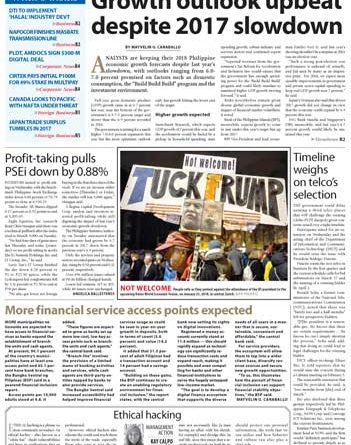MANILA: BUSINESS – Growth outlook upbeat despite 2017 slowdown
are keeping their 2018 Philippine economic growth forecasts despite last year’s slowdown, with outlooks ranging from 6.0-7.0 percent premised on factors such as domestic consumption, the “Build Build Build” program and the investment environment.
.
Full-year gross domestic product (GDP) growth came in at 6.7 percent last year, near the bottom of the government’s 6-5-7.5 percent target and slower than the 6.9 percent recorded in 2016.
The government is aiming for a much higher 7.0-8.0 percent expansion this year but the most optimistic outlook only has growth hitting the lower end of the target.
Higher growth expected
Metrobank Research, which expects GDP growth of 7 percent this year, said the acceleration would be fueled by a pickup in household spending, state spending growth, robust industry and services sectors and continued export expansion.
“Expected revenues from the government’s Tax Reform for Acceleration and Inclusion law would ensure that the government has enough spending power for the ‘Build Build Build’ program and could likely translate to sustained higher GDP growth moving forward,” it said.
Risks nevertheless remain given diverse global economic growth and impact of financial market volatilities, it noted.
Bank of the Philippine Islands (BPI), meanwhile, expects growth to come in just under this year’s target but up from 2017.
BPI Vice-President and lead economist Emilio Neri Jr. said last year’s showing shouldn’t be a surprise as 2016 was an election year.
“Such a strong post-election year performance is unheard of, actually, and [is]seen by many as an impressive print. For 2018, we expect more sizeable improvements in government and private sector capital spending to keep real GDP growth near 7 percent,” he said.
Japan’s Nomura also said that slower 2017 growth did not change its view that the economy could expand by 6.9 percent this year.
ING Bank Manila and Singapore’s DBS, meanwhile, said last year’s 6.7 percent growth would likely be sustained this year.
“Overall growth in 2017 is reasonable considering the high base of comparison,” ING Bank Manila senior economist Joey Cuyegkeng said.
He said the outlook for 2018 remained upbeat as the government would be rolling out major infrastructure projects.
DBS economist Gundy Cahyadi noted that domestic demand remained firm in the fourth quarter of 2017 and said this was expected to continue driving overall GDP growth in 2018 and 2019.
“We forecast steady GDP growth at 6.7 percent in 2018 and 2019,” he said.
‘Build Build Build’ crucial
A 6.7 percent outlook was also offered yesterday by Standard Chartered Bank, which said that the expansion would continue to be underpinned by strong domestic demand and infrastructure investments
“Our forecast for growth this year is 6.7 percent in line with what we said for 2017 as well,” said Chidu Naranayan, Asia economist for Standard Chartered, during an economic briefing.
“We think that it should be investments that will be the biggest driver of growth,” he added.
“We expect to see a bit more of the infrastructure that is being planned. We expect more of the planned infrastructure coming on board in 2018 which could be the biggest driver of growth.”
Growth over the next few years, Naranayan said, will depend on how fast the government implements its “Build Build Build” program.
“Over the medium-term it will be heavily dependent on the phase of the infrastructure implementation. The more we see that happening, the higher the chance of outperforming. So if we do see implementation of the entire planned infrastructure timeline, growth could be higher than 6.7 percent…,” he said.
Moderation likely
IHS Markit, BMI Research and Capital Economics, meanwhile, expect the economy to slow further this year.
IHS Markit chief economist Rajiv Biswas said outlook for 2018 was for GDP growth of 6.5 percent.
“With the global growth outlook having started 2018 on a very positive note, this is expected to boost export growth momentum for the Philippines for both goods and services, as well as creating a favorable environment for overseas worker remittances to strengthen,” he said.
Domestic demand is expected to remain strong in 2018, while investments will be boosted by the government’s plans to ramp up infrastructure spending.
BMI Research, for its part, noted that the strong third quarter result of 7 percent was unlikely to be sustained with leading financial market indicators showing signs of fatigue and the business environment also deteriorating.
“We continue to expect the economy to grow at a more moderate pace over the coming quarters and maintain our real GDP forecast at 6.3 percent in 2018 and 6.2 percent in 2019,” it said.
That said, the Fitch Group unit said that a 6 percent plus expansion was still strong by regional and historical standards. Supporting this will be positive demographic trends, a strong public infrastructure drive and deepening economic cooperation with China.
London-based consultancy Capital Economics was the least optimistic, forecasting a slowdown to 6 percent this year given moderating export growth and sluggish investments.
“Looking ahead, while we expect the Philippines to remain one of the fastest growing economies in the region, growth is likely to slow further in 2018,” it said.
Rate hikes expected
In related development, Standard Chartered said that strong domestic demand could also result in higher inflation and prompt the Bangko Sentral ng Pilipinas (BSP) to hike key interest rates.
“Inflation, we see it edging up this year and going up in the first half and flat in the second, averaging 3.5 percent. This is however not a worrying level and we don[t expect inflation to exceed the BSP’s (2.0-4.0 percent]target,” Naranayan said.
Standard Chartered, in a report, said headline inflation could peak at 3.8 percent in July.
“Domestic activity is likely to remain strong. Food inflation is likely to moderate but remain a key contributor to the headline,” it noted.
The rise in consumer prices picked up to 3.2 percent in 2017, up from 1.8 percent the previous year. The Bangko Sentral, which has a 3.4-percent forecast for this year, has said that economists expect a higher 3.6%-percent result.
Higher inflation and a continued increase in credit growth, Narayanan said, could lead to the BSP finally moving to adjust interest rates.
“[W]e are concerned on the credit growth for households, which has been running at 20 percent for the longest time. For corporate, it’s around 18 percent and these are very high numbers and monetary conditions have been the loosest in three years, so we think that the BSP will be worried…,” he said.
Standard Chartered expects “only two 25 bps (basis point) hikes from the BSP in 2018”, Narayanan said, the first one happening this quarter and the second likely in the third quarter.
“We don’t expect massive rate hikes from the central bank, only two rate hikes this year possibly in Q1 and Q3 and stopping there … not really tightening but tweaking to make it (the policy stance) less accommodating,” Naranayan said.
Peso outlook
Meanwhile, Standard Chartered foreign exchange strategist Divya Devesh said the bank expects the peso to continue depreciating this year, settling at around P50.50 to the US dollar by year-end.
“What has happened for the past months is that it the peso been overvalued to being close to fair valued. From an economist’s point of view, earlier the peso was too strong, current levels probably make more sense,” Devesh said.
“A weaker peso continues to be quite supportive of remittances inflows … Also as we know very well, imports being strong in the last few years ranging from capital goods to imports of raw materials and in that kind of environment, you won’t really want a stronger currency,” he added.
“I think a weaker currency would be better overall for the economy.”
WITH A REPORT FROM ANNA LEAH E. GONZALES
COURTESY:
BUSINESS TIMES
NOTE : All photographs, news, editorials, opinions, information, data, others have been taken from the Internet ..aseanews.net | [email protected] |
For comments, Email to :
Pahulu Gan – Contributor | [email protected]









